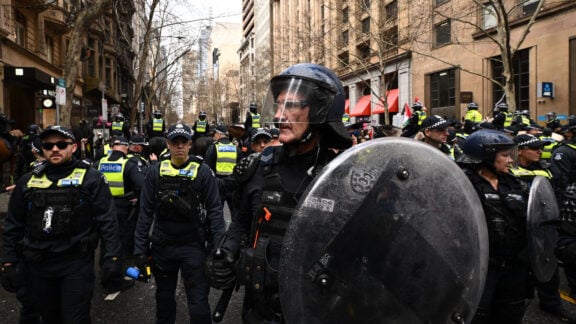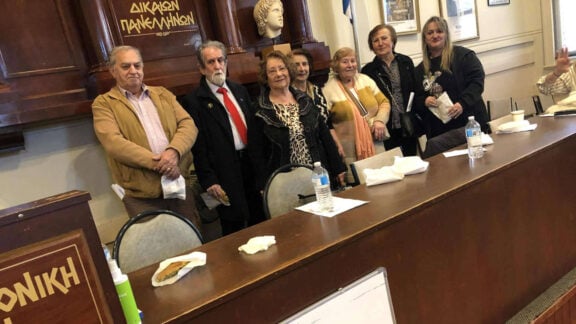The end of the month sees pictorial exhibition ‘From Imbros Over the Sea’ brought to Brisbane’s Greek Club by the Greek Orthodox Community of St George Brisbane. This follows on its launch in Melbourne last year and its successful showing recently as part of the Greek Festival in Sydney.
Tom Drakopoulos said on behalf of the organisers that the Brisbane Greek community was honoured to be able to bring such an important exhibition to Brisbane during the Anzac Day period.
“It is important that we not only recognise the Greek community of Imbros but also remember this important connection between Australians and Greeks”, he said.

The exhibition reveals the story of the role of the northern Aegean Island of Imbros and its Hellenic population in the Gallipoli campaign through the reproduction of many archival photographs and artworks, all explained by accompanying historical text and specially created maps. The exhibition consists of 21 large panels, devoted to the particular themes of Imbros’ involvement. The associated exhibition guide book will also available for purchase at the exhibition. This 132 page book tells the Imbros-Gallipoli story in more detail, with references for further reading and illustrated with 80 photographs and 3 original maps from the exhibition.

The exhibition was created by the Imvrian Society of Melbourne, with the support of the Victorian Government and Victorian Veterans Council as well as various donor organisations and individuals. The exhibition itself was researched and curated by Melbourne historian Jim Claven OAM who has been researching the role of Imbros in the campaign for over eight years. His research has encompassed his visit to the Island and its Gallipoli-related locations, with some of his photographs of these being included in the exhibition and book.
Claven is the author of the books Lemnos & Gallipoli Revealed as well as From Imbros Over the Sea.

The exhibition document the transformation of the Island into an armed camp. But for Claven some of the most poignant images are those depicting the interaction of the soldiers with the local Greek community, such as that taken Australian Private John David Rogers of the 6th Battalion in January 1916 depicting Australian soldiers dancing with local children in an unidentified village on Imbros.
“My research reveals that Australian and other Allied soldiers met locals on the shore or at their camps, partook of its produce, roamed the Island, visiting its villages and churches, stayed in their local inns and relaxed in its natural environment, enjoying a respite from the horrors of war. As on Lemnos, this created an important cultural connection between the Islands overwhelmingly Hellenic population and these young soldiers, a number of them Australian”, Claven said.

The Imvrians’ Society of Melbourne is a community group of descendants and friends of the island of Imbros. The organization was formed in 1970 and is located in Mentone. The Society’s project officer, George Xinos, worked with Claven on the exhibition project, playing a key role in laying out the exhibition panels and the creation of the exhibition maps.
Mr Xinos said that the launch is only the beginning for the project, with hopes that the exhibition will go on to be displayed at other Victorian venues and throughout Australia, as well as overseas, hopefully on Imbros itself.
“The aim of this project is raise awareness and to begin a conversation on how we can appropriately remember and commemorate this important part of the Island and Australia’s history.

As Claven told Neos Kosmos, every year tens of thousands of Australians visit the battlefields and graves on the Gallipoli Peninsula.
“We want to work to promote and help create a Gallipoli Heritage Trail on Imbros, emulating that recently begun on Lemnos, to encourage new visitors to Imbros,” Xinos said.
Xinos pointed out that recent years have seen a resurgence of Greek community life on Imbros, with the permanent population growing from 200 a few years ago to now approaching 600. Primary and Secondary Schools have been established, catering for the local Greek community children. These developments have been supported by the local authorities and the Greek Orthodox Patriarchate – many will be aware that the Patriarch Bartholomew is also a native of the Island.
Claven thanks the Imvrian Society of Melbourne for its foresight in supporting this project. He also wishes to thank the First World War Aviation Society in the United Kingdom for its generosity in allowing the reproduction of many photographs from its collection. He also places on record his thanks to David Sanderson of the Brotherhood of Greek Campaign Veterans in the United Kingdom for his assistance in accessing the original campaign maps of Imbros held by the National Archives in London.

The exhibition is scheduled to be shown at the Greek Club in South Brisbane.
The launch will take place on Friday 26 April, with an introductory presentation by Jim Claven, followed by the exhibition being open to the public over the weekend (27-28 April).
The presentation on the exhibition will commence at 6.30pm and will be in English. The exhibition is free and no bookings are necessary.
Those interested in purchasing the exhibition guide book should contact George Xinos – georgexinos@gmail.com







